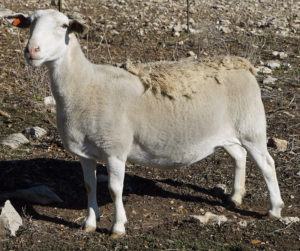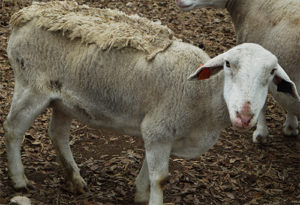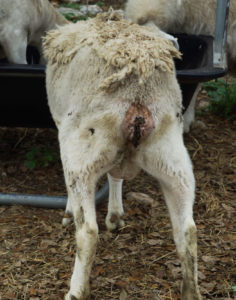True story from the field highlighting the chronic nature of MAP-infections and the rapid onset of clinical signs.
 Shown here is a Dorper sheep (a fast-growing meat-producing sheep breed) born April 2015 in the U.S. In June of 2019, as part of a whole-flock test for Johne’s disease using pooled fecal PCR, this animal tested PCR-positive. The PCR Ct value was 25 indicating high levels of MAP shedding in feces (estimated at 10,000,000 MAP per gram of feces). And yet this ewe which was 4-years-old at the time of testing, was clinically normal, as seen in the photo to the right taken just 60 days before the clinical signs began (age 4.9 years). It should be noted that this ewe produced son that was a grand champion and one of the more valuable animals in the flock. So, she was placed in isolation on the ranch.
Shown here is a Dorper sheep (a fast-growing meat-producing sheep breed) born April 2015 in the U.S. In June of 2019, as part of a whole-flock test for Johne’s disease using pooled fecal PCR, this animal tested PCR-positive. The PCR Ct value was 25 indicating high levels of MAP shedding in feces (estimated at 10,000,000 MAP per gram of feces). And yet this ewe which was 4-years-old at the time of testing, was clinically normal, as seen in the photo to the right taken just 60 days before the clinical signs began (age 4.9 years). It should be noted that this ewe produced son that was a grand champion and one of the more valuable animals in the flock. So, she was placed in isolation on the ranch.
 By April of 2020 (10 months after testing PCR-positive) this ewe was showing clinical signs of Johne’s disease. The rapid decline in body condition occurred in a matter of a few weeks. The next two images show her side-view and rear-view.
By April of 2020 (10 months after testing PCR-positive) this ewe was showing clinical signs of Johne’s disease. The rapid decline in body condition occurred in a matter of a few weeks. The next two images show her side-view and rear-view.
 This series of slides illustrates the insidious nature of Johne’s disease. It silently enters sheep flocks with purchased animals, it slowly spreads to lambs in the flock. Scientific consensus is that most animal become MAP-infected soon after birth. The incubation period (period from infection to clinical signs) is long – in this animal at least 4 years. Even when the infection is fairly advanced and the sheep is shedding millions of MAP per gram of feces, the animal looks in perfect health. However, inevitably the animal develops clinical signs of Johne’s disease, weight loss and pasty feces.
This series of slides illustrates the insidious nature of Johne’s disease. It silently enters sheep flocks with purchased animals, it slowly spreads to lambs in the flock. Scientific consensus is that most animal become MAP-infected soon after birth. The incubation period (period from infection to clinical signs) is long – in this animal at least 4 years. Even when the infection is fairly advanced and the sheep is shedding millions of MAP per gram of feces, the animal looks in perfect health. However, inevitably the animal develops clinical signs of Johne’s disease, weight loss and pasty feces.
Although the animal has been MAP-infected for most of its life, the onset of clinical disease is sudden. Owners can mistakenly assume that the MAP-infection was recent when in fact the animal was infected for most of its life and shedding massive numbers of MAP capable of infecting lambs born on the property. This is why the infection is so insidious and why routine whole flock (or herd) testing using the most sensitive diagnostic test (PCR) is critical for effective control of Johne’s disease.
Side note: This problem occurred in a registered breeding flock with excellent animal husbandry and nutrition. In less well-managed flocks clinical signs may have appeared earlier.
Lessons:
- To avoid this problem, pre-purchase testing of the flocks you intend to buy from is vital.
- To diagnose the problem early before too many sheep are infected, annual whole-flock testing by fecal PCR is essential.
- Johne’s disease is a major risk to elite breeding sheep flocks and can force a loss of valuable genetics. This makes Johne’s disease an industry-wide problem that every breeder should tackle.
For more images of sheep with clinical paratuberculosis, visit this page of our website.
We are grateful for the information and photos provided by the flock owners for this story.